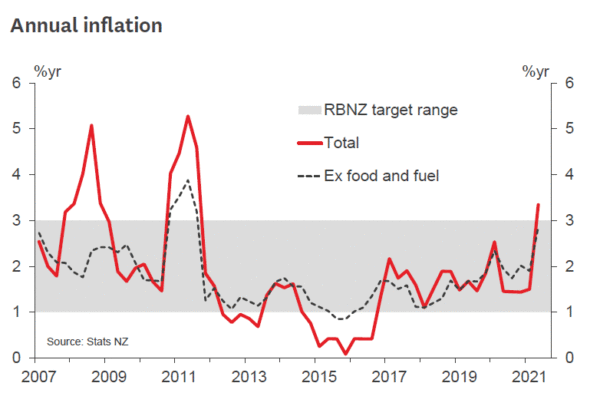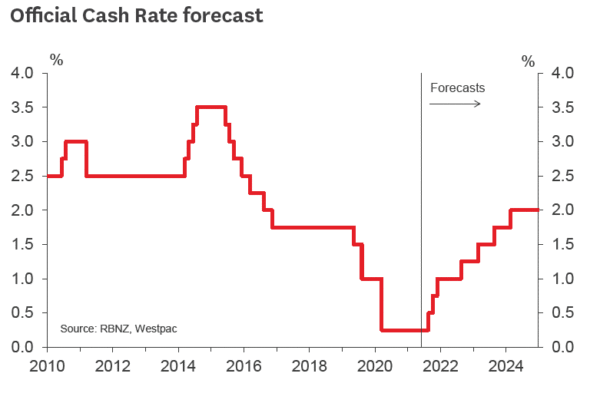- We expect that the RBNZ will increase the cash rate by 0.25 ppts at the time of the August Monetary Policy Statement, and that this will be followed by 0.25 ppt increases at both the October review and at the November Monetary Policy Statement.
- Underlying our expectations for this sequence of rate hikes are signs of solid momentum in domestic economic activity, as well as a strong increase in inflation pressures.
- Last Wednesday’s announcement from the RBNZ highlighted that the central bank is ready and willing to adjust policy settings as economic conditions dictate. It also showed that they are ready to adjust policy at ‘Review’ meetings (not just when they release ‘Monetary Policy Statements’).
- We think that today’s CPI result, along with other recent developments will see the RBNZ revising up their assessment of medium-term inflation pressures. That means OCR hikes are also likely to come faster
We have updated our forecast for the Official Cash Rate.
As we detailed earlier this week, we now expect that the RBNZ will increase the cash rate by 0.25 ppts at the time of the August Monetary Policy Statement.
This is expected to be followed by 0.25 ppt increases at both the October review and at the November Monetary Policy Statement.
Following the November policy statement, we expect that the RBNZ will pause to assess how the economy is tracking, with further gradual rate increases beginning again in mid-2022.
Underlying our expectations for this sequence of rate hikes are signs of solid momentum in domestic economic activity, as well as clear signs that the strength in demand is flowing through to a strong increase in inflation pressures. That combination of conditions was evident in today’s inflation release.
Consumer prices rose by 1.3% in the June quarter. That was well above our forecast and the median market prediction
The result was also much higher than the 0.6% increase the RBNZ assumed in its last set of published forecasts (released in May).
Today’s sharp increase took the annual inflation rate to 3.3% – above the RBNZ’s target band and the highest pace in a decade. The last time inflation was this high was after 2010’s GST increase.
Inflation has been boosted by very large increases in construction costs, as well as increases in petrol prices. However, inflation pressures have been broad based. That was reflected in the measures of core (underlying) inflation which have spiked higher. In fact, most of the core inflation measures released by Stats NZ today were at or above 3% (previously they were around 2%).
In part, this strength in inflation has been due to disruptions to supply chains and the closure of the borders in the wake of last year’s outbreak. The resulting shortages of materials, finished goods and labour have all pushed costs of production higher for local businesses.
However, the more notable development has been the strength of consumer demand. That has given businesses greater leeway to pass on cost increases into the prices of consumer goods.
We expect that inflation will linger above the RBNZ’s 1 to 3% target band for the remainder of this year and the early part of 2022. While we do expect that inflation will moderate further ahead as supply constraints ease, the current strength in inflation is likely to see inflation expectations pushing to levels above the RBNZ’s 2% target. Recent months have already seen some measures of expectations starting to creep higher. And if this becomes embedded in wage and price setting decisions, it would be a major concern for the central bank as it could result in a more protracted inflation cycle.
On top of the lift in inflation, mid-2021 has seen solid momentum in economic activity, including firmness in household spending, construction activity and surveys of business conditions. As a result, it’s now looking likely that the strong 1.6% rise in March quarter GDP will be followed by another strong print in June.
In addition, we’re also seeing related positive indications for the labour market, with strength in hiring intentions and job ads, as well as widespread reports of labour shortages. That points to a continued drop in the unemployment rate over the coming quarters, along with a lift in wage inflation.
Putting this altogether, the current level of monetary stimulus (which was put in place when the economy entered Level 4 lockdown) is no longer appropriate. The elimination of Covid on our shores means that domestic households and businesses have been able to operate largely free from restrictions. That’s meant that (in contrast to regions like the US and Australia), domestic economic activity is now back around trend.
Wednesday’s announcement from the RBNZ highlighted that the central bank is ready and willing to adjust policy settings as economic conditions dictate. And they clearly don’t see the distinction between a ‘Policy Review’ and ‘Monetary Policy Statement’ as a hurdle. Rather than waiting until August (when they will release a full statement and projections), the RBNZ effectively kicked off the tightening cycle at an interim review when it announced the cessation of the LSAP programme. That clearly signalled that the RBNZ thinks the inflation outlook is strong enough to warrant acting now, rather than waiting six weeks.
We think that today’s result, along with other recent developments will see the RBNZ revising up their assessment of medium-term inflation pressures. And that means that OCR hikes are also likely to come faster 













